- HOME
- Website Building
- Testimonials
- Examples of Great Testimonials
Examples of Great Testimonials
- 7 Mins Read
- Posted on April 15, 2018
- Last Updated on October 8, 2024
- By Lauren
Stop for a moment, and think of a few customer review or testimonials you’ve read. From those, focus on one example testimonial that’s persuaded you to become a customer.
What is it that makes that testimonial so powerful and compelling? If you tried to name specific qualities, your list might look like this:
- It offers specifics about the customer’s experience
- The testimonial tells a before-and-after story
- It preempts or answers an objection
- Most of all, it feels authentic
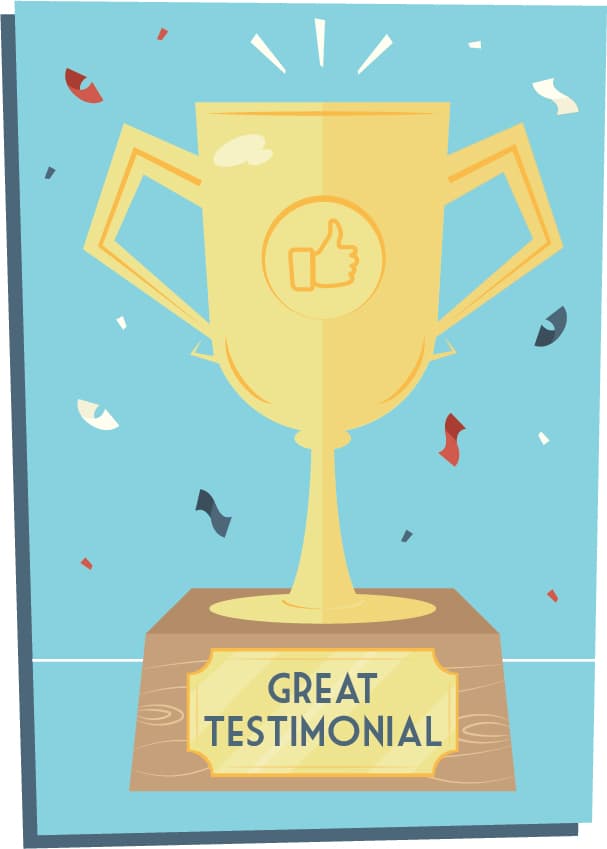 These are the four most essential characteristics of a great testimonial. Combined, they encourage the reader to identify with the testimonial writer. A good testimonial also helps the reader image what their lives would be like if they used your product or service.
These are the four most essential characteristics of a great testimonial. Combined, they encourage the reader to identify with the testimonial writer. A good testimonial also helps the reader image what their lives would be like if they used your product or service.
Even if you can’t recall a specific exceptional testimonial you’ve seen, you can likely imagine one based on this list. But it’s always easier to learn from example. With that in mind, let’s look at some of our favorite testimonials, so you can see those qualities in action.
Case Study Buddy: Use testimonials to differentiate yourself and substantiate your authority
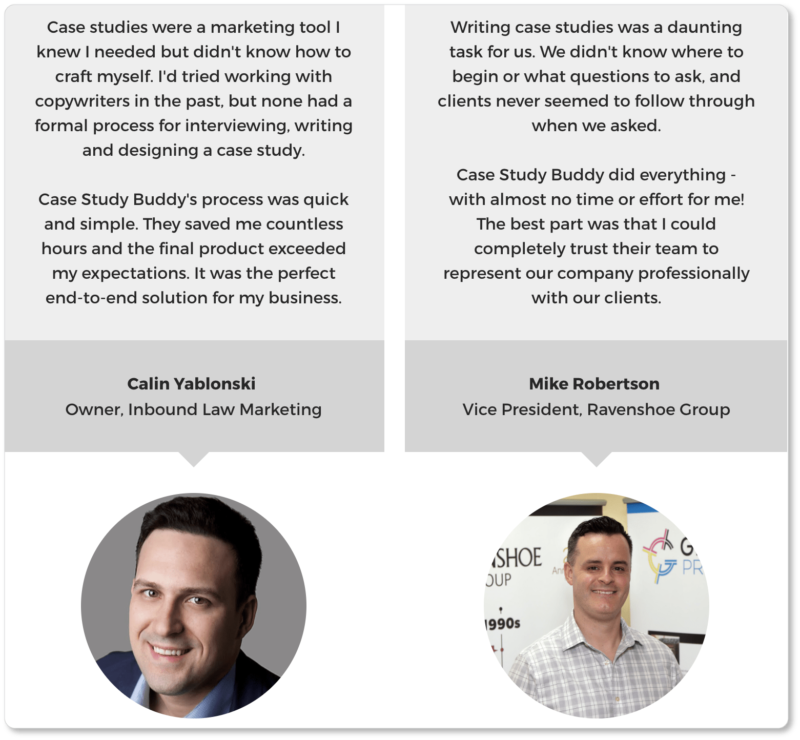
Both of these example testimonials from Case Study Buddy appeal to a reader concerned about their lack of knowledge. They might be uncertain about whether Case Study Buddy can work well with a client who “doesn’t know where to begin.”
This is the objection that both testimonials quietly raise and then quickly dispel. In the testimonial on the left, the client’s lack of experience didn’t matter, because Case Study Buddy’s process turned out to be “simple.” In the testimonial on the right, the client’s lack of experience wasn’t important because “Case Study Buddy did everything.”
What’s more, the testimonial on the left helps Case Study Buddy stand out from its competitors. The happy customer says, “I’d tried working with copywriters in the past.” He then goes on to explicitly state what that difference is: Case Study Buddy employs a formal process, where previous services didn’t. That’s why questions such as “Had you tried other services before ours? If so, what were the results?” and “Was there a feature of our service that ultimately made you choose to buy?” are great ones to ask your clients. These are the kinds of details you’ll get when you pose the questions this way.
Finally, the titles of these reviewers—Owner and Vice President—make a difference. Case Study Buddy has landed testimonials from people in positions of influence in their own industries. That gives their testimonials an air of authority they might not have otherwise.
Square: Testimonials can offer “proof over praise” with specific data
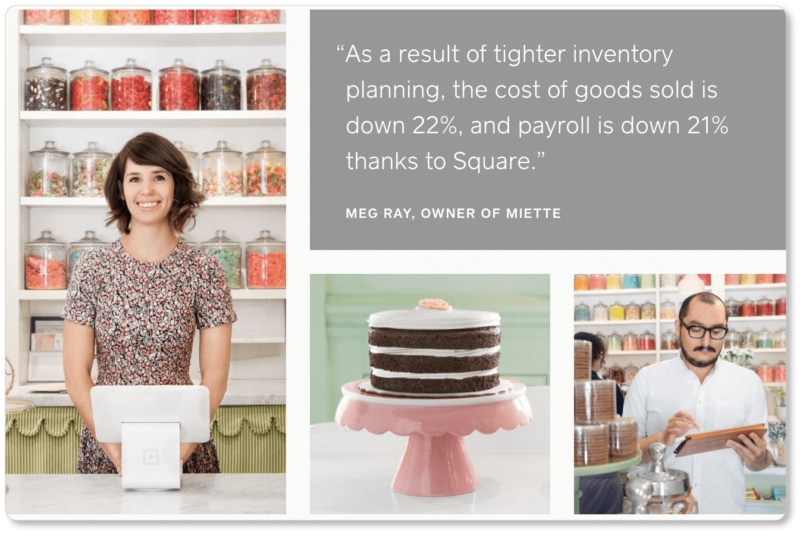
This example from Square is comparatively short, but it packs a punch thanks to its data. Prospects scrolling Square’s site without the time (or patience) to read all the text will be drawn to the testimonial because of the bright, friendly design. The images also add a touch of authenticity to the testimonial. Even more importantly, there are two eye-catching statistics in one short sentence. Remember: numbers will always have a stronger impact than adjectives do.
This is why it’s important to ask your clients how they’ve specifically benefited from your product/service. Adding those details to the end result makes a much more powerful result. Meg’s testimonial could have read, “The cost of goods sold is down, and payroll is down thanks to Square.” But it wouldn’t have been as persuasive as seeing those percentages in the twenties. She did well (and she did well for Square) to add them.
But the copy has certainly done its work here.
Bergman Family Chiropractic: Tell a before-and-after story with your testimonials
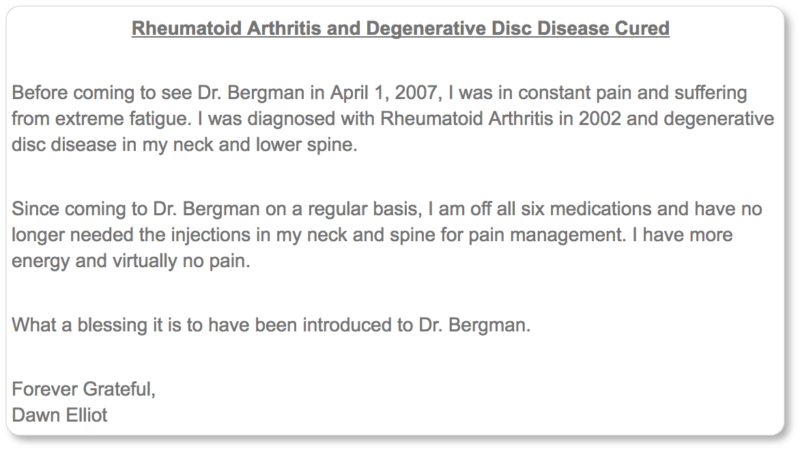
This testimonial from Bergman Family Chiropractic offers a before-and-after story. More than that, the story has facts and details. Dawn offers specifics such as dates, the problems she was struggling with when she first came to Dr. Bergman. She also states unequivocal outcomes (“off all six medications” and “no longer need the injections in my neck and spine”).
If we were going to make chances, we’d add two things:
- A photograph of Dawn (if not other information about her) to make the testimonial appear more authentic
- Some design elements to draw site visitors’ eyes towards the text
But the copy has certainly done its work here. And of course, it’s always better to have a meaty but plain testimonial than it is to have a flashy design and no substance.
SalesFolk: Create a multimedia testimonials page
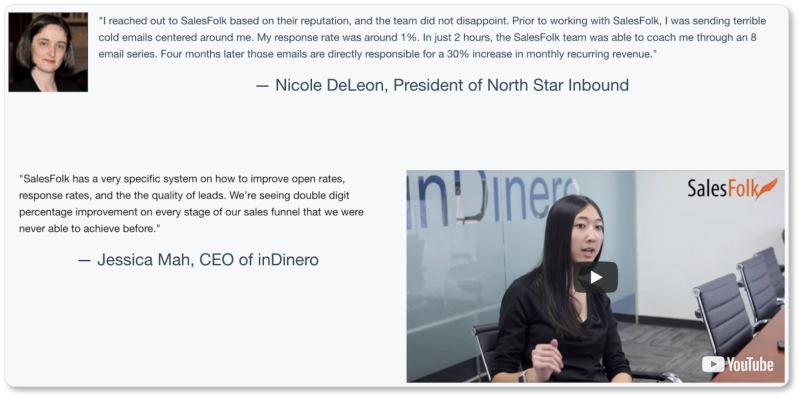
SalesFolk does a lot right on its testimonials page. These testimonials:
- Showcase specific outcomes customers have experienced
- Spotlight SalesFolk’s reputation as an authority in its field
- Mention the influential positions its reviewers hold in their respective companies
However, what really stands out here is the video testimonial. Video testimonials are visually compelling, and they let visitors hear the benefits of working with your company without doing the work of reading. Videos also win the gold medal in the authenticity category.
What does this particular video testimonial do well? Let’s break it down:
- It sounds off-the-cuff and unscripted, making it appear more genuine
- The video is short, clocking in at less than a minute and a half long
- Numerical data is included (“double-digit percentage improvements”)
- The video also includes specific features of the service SalesFolk offers (SalesFolk has “a very specific system for how to improve the open rates, the response rates, the quality of leads”; “they’re helping us write far more custom, targeted emails”)
SalesFolk also includes a text excerpt from their testimonial to the left of the video. Videos are a powerful tool for businesses because they allow you to offer both multimedia and great copy at the same time.
AWeber: Keep it conversational…but know your prospects
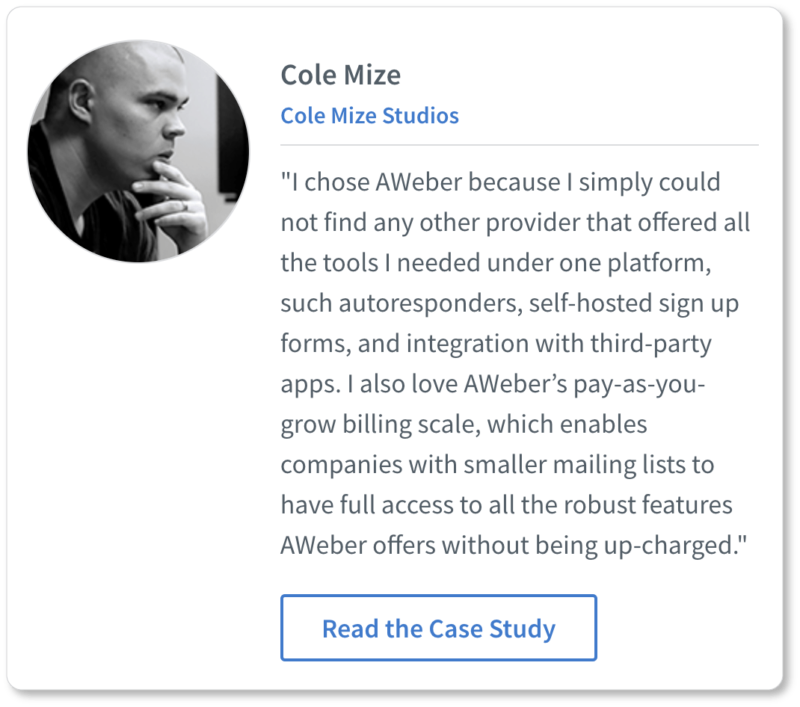
This example testimonial from AWeber—which is excerpted from a longer case study—showcases exactly what AWeber’s product does. In fact, the writer mentions specific AWeber features and tools he likes and uses.
This is a way of handing the microphone over to customers and letting them explain—in conversational language—what prospects can expect when they use AWeber’s services. While it’s conversational, you’ll also note that there is some jargon here. The testimonial uses language that’s likely be familiar to more tech-savvy users, like “autoresponders” and “integration with third-party apps.”
In other words, this testimonial understands whom it’s speaking to—and who AWeber’s ideal prospect is. It doesn’t talk down or condescend to prospects who know these terms by explaining what they mean. It also helps visitors determine whether they’re the right users for AWeber’s services.
Fourlane: Use testimonials to highlight the individuals in your company

This testimonial references a specific employee at Fourlane. These kinds of employee-specific testimonials have at least two benefits:
- Individual testimonials can be terrific for company culture – Linn is probably pleased that her work is being recognized on the company website.
- The reviewer being able to describe her experience with Fourlane on a first-name basis shows readers that the company offers a personalized experience to its clients.
Allowing your customers to praise specific employees always looks good for the business as a whole. In fact, the more of these you have, the more readers will get an impression of your company as a group of remarkable team players. Don’t hinder your clients from offering specific praise!
JazzHR: Make it look (and sound) authentic
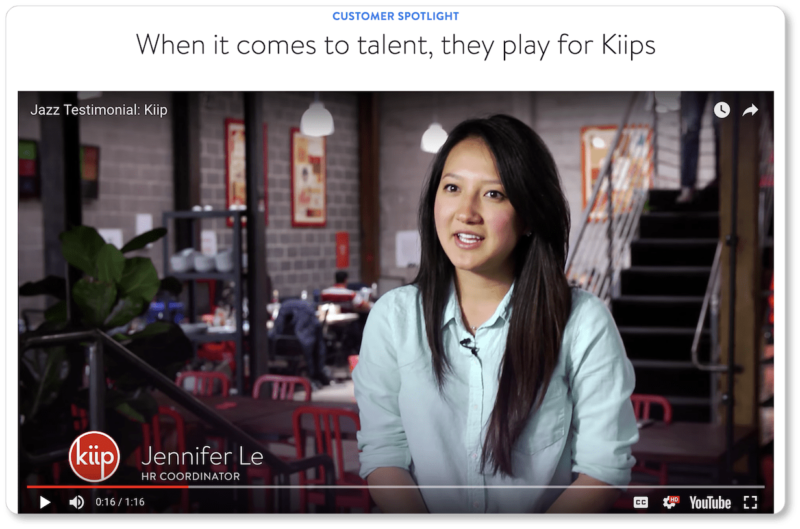
Proof of authenticity in your customer testimonials includes photographs of the writer, their name and job description, the name of their business, and their social media handles or a website that a visitor can link to from your site.
But of course, video testimonials evoke authenticity in a way that those proofs simply can’t. Here’s an example from recruitment software JazzHR’s testimonial page:
What we love most about this testimonial is that we get to learn about JazzHR’s client, Kiip, before we even discover why they love JazzHR so much. The first half of the video is dedicated to depicting the company culture at Kiip. It takes care in showing the values the company holds—particularly when it comes to their hiring process.
In other words, we first get a clear picture of a business that uses JazzHR for its hiring process. We discover that JazzHR’s client base includes exceptional, value-driven businesses. We learn that their recruiting software lets their clients hold tight to their company values. And because we become endeared to Kiip as we get a brief tour of their business, we feel more positively about JazzHR’s product, which Kiip uses and trusts.
This, too, may seem counter-intuitive: Why let someone else talk about their own business for so long in a testimonial for your company? But as prospects begin to understand the kinds of amazing businesses you work with, they’ll grow more eager to be a part of the culture you’re creating and helping sustain. They’re also more likely to believe that you are a part of the reason those businesses are as amazing as they are.
Discover the testimonial style that fits your business
That’s our shortlist of great examples. But when you sit down to collect your testimonials, don’t limit yourself. Put yourself in your customers’ shoes. Think about what they’ll want or need to hear. While there are plenty of sub-par testimonials on the internet, there are also plenty of fantastic examples. Spend some time on the sites of your favorite businesses and take a look at what their customer reviews and testimonials to get inspiration.
In the next section, we offer recommendations for positioning your testimonials on your website to increase conversions. After all, your testimonials can only pack a punch if they’re both prominently and intelligently placed.

